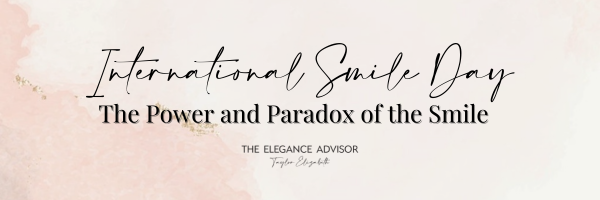Happy International Smile Day, everyone!
I discovered the significance of this day through a heartwarming conversation with my 7-year-old daughter. With a grin on her face, she announced, “Friday is smile day all around the world, and we have to smile no matter what!” While her innocent enthusiasm was contagious, it also led me to reflect upon the profound message behind her words.
As a Massachusetts native, I am proud to say I have another connection to the origins of International Smile day. Local artist Harvey Ball is famed for creating the iconic Smiley Face in 1963 and that is where International Smile Day was born. Honestly, it couldn’t be a more perfect idea. A day dedicated to the simple, yet powerful act of smiling.
Being an American, the stereotype often pegged to us is that we’re always wearing a smile. Though it’s true we do smile a lot, the crown for the “most smiley country” goes to Finland. (Bravo, Finland!) But as an emotional intelligence and etiquette coach, my daughter’s words resonated differently. Beyond the cultural or habitual reasons to smile, there’s a deeper emotional and psychological dimension to it.
While I am an advocate for expressing authentic emotions and believe in the power of emotional intelligence – encompassing awareness, emotional regulation, empathy, motivation, and more – I found myself pondering: Should we really smile no matter what? Is it humanly possible? Every emotion holds its value, not just the ones easily processed or universally accepted or “more acceptable”.
However, the conversation did spark a curiosity about the myriad facets of smiling. Let’s break it down a bit:
 Physiologically, smiling is not a mere facial twitch. It involves 20 different muscles and is universally recognized, making it a universally accepted gesture of happiness and goodwill.
Physiologically, smiling is not a mere facial twitch. It involves 20 different muscles and is universally recognized, making it a universally accepted gesture of happiness and goodwill.
Emotionally, a smile has the power to elevate moods and reduce stress. Regular smilers often radiate positivity and are seen as more likable and trustworthy.
Psychologically, not every smile is genuine. For instance, sometimes people smile as a defense mechanism, trying to mask their true feelings or discomfort. And while the age-old saying of “Fake it till you make it” holds some truth, relying solely on a smile isn’t the antidote to life’s challenges.
Culturally, while smiles symbolize happiness globally, their usage varies. In the West, they’re common courtesies, even among strangers. In parts of Asia, over-smiling can seem insincere. In Russia, smiling at strangers can be seen as intrusive. It’s vital to recognize these nuances when interacting across cultures, as context enriches the meaning of a smile.
Before we delve further into the emotional intelligence realm, let’s examine some ways to enhance our smiling prowess.
Tips to Master the Art of Smiling
Smiling is a powerful tool in our emotional arsenal, and mastering it can make a world of difference in our interactions and overall well-being. Here are three practical tips to hone your smiling skills:
- Practice Authenticity: Start by recognizing your emotions. Aim to be genuine in your expressions. If you’re feeling down, it’s okay not to smile. When you do smile, let it come from a place of authenticity.
- Smile with your Eyes: A Duchenne smile is one where not only the mouth but also the eyes are involved. To convey genuine happiness and warmth, remember to involve your eyes in the smile.
- Mirror Practice: Spend a few minutes every day practicing different smiles. Over time, this can make you more confident in your expressions, ensuring that your smiles are both genuine and impactful.
Having these tools at your disposal can certainly enhance your interpersonal relationships and your overall emotional health.
Smiling holds undeniable significance. It can foster empathy, aid in regulating emotions, and build trust. But it’s also essential to remember that it’s okay not to smile sometimes. Every emotion has its space and deserves to be acknowledged.
I encourage you, as we celebrate International Smile Day. Let’s appreciate the power of a smile, but also respect the full spectrum of human emotions. After all, understanding our emotions and those of others is the essence of being emotionally intelligent.
Happy smiling, and sometimes, not smiling!
Until next time. Stay Elegant,








Comments